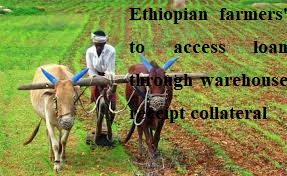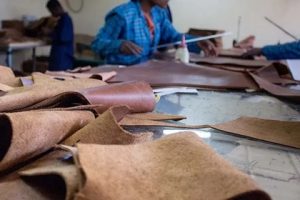
Industrialization, which the industrial modification has placed at the heart of structural changes, has systematically raised the levels of production and employment, which has led to fresh income growth.
Cognizant of the fact that promoting the development of the industrial sector can be a key to achieving sustainable development, growth and economic advancement, The Ethiopian Herald wanted to solicit viable information from the qualified expert goes by the name Ashenafi Buta, who graduated in Industrial Engineering from Bahir Dar University.
He said, “The effect of industrialization on economic development has been vital, indeed! It brings about increased volume and varieties of manufactured goods resulting in increased employment and improved standard of living of the citizens. In the process of economic growth, it is the industrial sector which plays the role of engine of growth, as the potential productivity growth is the highest in this sector.”
He further stated that the industrial sector can power the economy with the right policies for it will promptly transform the sluggish recovery into an economic resurgence.
“Indeed, it is recognized that Ethiopia, as other countries of the globe, will find difficult to create the wealth necessary for the eradication of extreme poverty without a real industrialization capable of generating added value. In fact, the word industry is used essentially as a synonym for manufacturing. It refers usually to changing of raw materials into products of more value. However, industry refers to an organized human skill and efforts to produce something more valuable and useful from the gifts of natural resources and primary products. It refers to the process of manufacturing,” he added.
Ethiopia has successively defined several industrial development strategies in order to give importance to the sector and to promote economic growth and redistribution of income though a lot remains to be done. Its journey has been towards industrialization in fact through expanding industrialization, the government would be able to promote the emergence and expansion of domestic industries by replacing major sub sectors such as textile, shoes and food processing.
As to Ashenafi, the impact of industrialization on economic growth can be identified by the rate of manufacturing firms, and the increase in industrial output will increase economic growth of the country. Therefore, undoubtedly there is significant relationship between industrial development and economy growth.
Hence, some policy measures have to inject so as to boost industrial output by improving the overall productivity of all the sectors and ensure sustainable development economic and socio-political change, he added.
“The government should create a good environment for industrial growth through, as far as I am concerned, providing conducive investment environment by removing the structural rigidity that exist in the economy to encourage industrial activities, rendering stable supply of power, good roads for transportation of goods and people, functional legal system, security of lives and property, infrastructural facilities as well as applying good governance mechanism and a good legal framework to protect property rights,” he underscored.
In so doing, as to him, it would be quite possible towards improving a social and economic infrastructure, especially electricity supply and functional education via improving diffusion of technology and making Ethiopia’s manufacturers more competitive. Besides, it would be of significantly useful in improving the quality of the work factor on behalf of firms and fighting against corruption and the further improvement of the regulatory framework to reduce the operating costs of business enterprises.
Yes he added the rationalization of industrial structure and upgrading of the industrial structure has an impact on economic growth, foreign trade, scientific and technological innovations that are the main factors affecting regional economic growth.
He said, “Of course, the new development pattern of domestic and international dual circulation and mutual promotion, further expands the level of opening up, effectively playing the role of free trade pilot areas, free trade ports, special economic zones, development zones, bonded areas, and other frontier highlands, improve the level and capacity of foreign trade.”
Investment attraction has always been an important starting point for the development of the national economy. As it has become difficult to attract investment due to the weak industrial foundation in the country, the government should establish a more effective new mechanism for coordinated development and optimization of industrial structure, promote the transfer of industries across the nation and inject fresh blood into industrial development and lay a foundation for a well-coordinated economic and financial development, he underlined.
According to Ashenafi, the government had better implemented innovation-driven policies and promote the optimization of industrial structure. Innovation is the first driving force to lead development, and it is necessary to lead new industries, new formats, and new business models to promote economic development through innovation.
Besides, it is quite better focus on the construction of a modern industrial system, accelerate the optimization and upgrading of industrial structure, promote the construction of a strong province with scientific and technological innovation, and actively create a new situation in the county.
When promoting the optimization of industrial structure, the country should focus on the internal adjustment of industrial structure, actively cultivate new economic growth points, accelerate the development of the modern service industry, promote the development of the productive service industry, and extend from low-end to professional, middle and high-end of the value chain.
Knowing that the manufacturing industry is highly relying on scientific and technological innovation to build a new industrial system, Ethiopia has to prettily embark on making full use of national advantages to promote the optimization of the industrial structure accordant to local circumstances, he added.
As to Ashenafi, making full use of the good opportunity for the country to promote the new development pattern of domestic and international industrial opportunities is an incomparable path towards real economic change and growth.
A range of policies can promote industrial energy and materials efficiency, often with positive impacts on firms’ financial performance as well as the environment. Promoting materials recycling and reuse is found to be an effective if indirect means of conserving energy. If successful in accelerating economic growth, this process involves shifting resources from low- to high-productivity sectors.
More broadly, sustained economic growth is associated with the capacity to diversify domestic production structure: that is, to generate new activities, to strengthen economic linkages within the country and to create domestic technological capabilities. The industrial and modern service sectors typically contribute dynamically to this diversification process. Reflection on industrial policies in developing countries should be concerned with three important dimensions: innovations, linkages and surplus labor. Innovations, in turn, tend to be different in developing countries and in developed countries, Ashenafi underscored.
For industrial countries, moving the technological frontier, or developing new non-technological practices are the major forms of innovation. Entrepreneurs are the ones who organize and lead such forays into unexplored territory. Their appetite for risk may, however, be dulled if the prospect of profiting from a successful discovery is small.
This growth is driven by a range of factors, including the increased global demand for raw materials, the rise of foreign direct investment (FDI), and the development of infrastructure. Industrial development is a key component of economic growth in Africa. It helps create jobs, diversify the economy, and reduce dependence on raw material exports.
He said, “Moving people out of informal subsistence farming into formal manufacturing jobs improves their productivity, makes the agriculture sector more efficient, and raises government revenues through taxation. It is well attested that thriving manufacturing sector is key to increased productivity, and thereby economic growth. Manufacturing tends to have strong linkages to other parts of the economy, creating demand for skills, inputs, manufacturing components, transportation and storage. This means that growth in manufacturing boosts growth throughout a broader set of activities, including in the service sector. Third, most innovation and technological advances originate in the manufacturing sector, which can then feed into other economic sectors, making them more productive as well.”
In sum, the relationship between industry and growth generally holds across countries and income levels. International data confirms that the proportion of manufacturing in the economy rises as gross domestic product (GDP) increases for low, lower-middle and upper-middle-income countries. This correlation only reverses once a country becomes a high-income economy, where services start to take a relatively higher share than manufacturing.
Ethiopia has emerged as one of the fastest-growing economies in Africa in the early twenty-first century. The focus has been on sectors such as leather and leather goods, apparel and textiles, meat processing, food processing and beverages, cement and steel, and horticulture. There has also been recognition of reciprocity and the political economy constraints that hinder productive investment in export-oriented manufacturing.
BY MENGESHA AMARE
THE ETHIOPIAN HERALD FRIDAY 12 APRIL 2024





